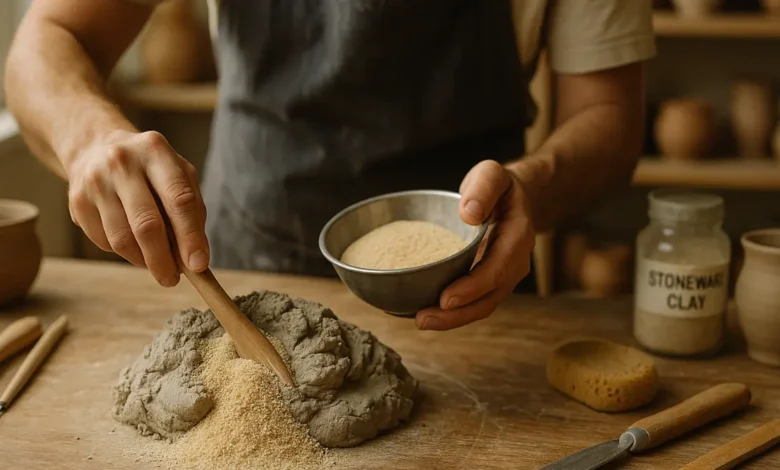Mastering Sand for Ceramic Clay: Expert Tips for Perfect Texture and Strength

Discover how to use sand for ceramic clay to improve texture, reduce cracks, and boost strength. Learn the best sand types, mixing ratios, and expert techniques for flawless pottery results.
When it comes to crafting ceramics that are both beautiful and durable, one ingredient often gets overlooked — sand for ceramic clay. While most people focus on the type of clay or glaze used, sand plays a critical role in the structure, texture, and strength of ceramic works. Whether you’re a potter, sculptor, or hobbyist, understanding how sand interacts with clay can completely transform your results.
This guide explores everything you need to know about using sand for ceramic clay — from why it’s used and what types to choose, to mixing techniques, benefits, and expert insights. By the end, you’ll have a full understanding of how to use sand like a pro and create ceramics that stand out in both quality and artistry.
Understanding the Role of Sand in Ceramic Clay
Sand in ceramic clay isn’t just filler — it’s a performance enhancer. It gives clay structure, controls shrinkage, and adds texture that many artists love. When clay dries, it tends to contract, which can cause cracking or warping. Sand reduces this shrinkage by interrupting the clay particles and providing stability.
In addition, sand improves the “tooth” of the clay, meaning it gives a rougher feel that helps sculptors shape and mold without slippage. This makes it essential for hand-building, large forms, and sculptural pieces that need internal support.
The amount and type of sand you use will depend on your goal. For instance, fine sand creates smoother textures for pottery, while coarse sand is perfect for rugged, rustic-looking sculptures.
Why Artists Add Sand to Ceramic Clay
Artists use sand for ceramic clay for both functional and creative reasons. Functionally, sand helps control cracking, adds durability, and enhances workability. Creatively, it allows for textures and surfaces that pure clay can’t easily achieve.
When mixed properly, sand gives clay a balanced structure that resists warping during drying or firing. It’s also highly customizable — you can choose fine, medium, or coarse sand depending on the finish you want. Some artists even mix different sand grades to create unique visual effects.
Think of sand as the secret ingredient that helps you achieve the perfect balance between smoothness, strength, and texture.
Types of Sand for Ceramic Clay
Not all sands are created equal. The right sand makes all the difference in how your clay behaves during shaping and firing. Below are the main types of sand used in ceramic clay work:
| Type of Sand | Description | Best Used For |
|---|---|---|
| Silica Sand | Made from finely ground quartz, offers excellent heat resistance and strength. | Stoneware, porcelain, and high-fire clays. |
| River Sand | Naturally rounded grains, smoother texture. | Earthenware and hand-building projects. |
| Crushed Granite Sand | Coarse, irregular texture adds character and strength. | Sculptural or large-scale pieces. |
| Beach Sand | Contains salts and impurities; must be cleaned before use. | Experimental or decorative clay work. |
| Mason’s Sand | Commercially available, clean, and consistent. | General-purpose ceramic clay mixing. |
Each type offers its own character and handling qualities. Most potters prefer silica sand because it provides a reliable, inert addition to clay bodies. However, for more natural or textured looks, river sand and granite sand can bring more personality.
The Science Behind Sand and Clay Interaction
At the molecular level, clay consists of tiny plate-like particles that hold water between them. When these particles dry, they draw closer together, which leads to shrinkage. Sand, however, doesn’t absorb water — it acts like a “spacer” that prevents excessive compaction.
This scientific interaction is the reason sand helps reduce cracking. It limits the movement of clay particles during drying and firing, creating a more stable structure.
Furthermore, sand increases thermal shock resistance. This means your pottery is less likely to crack when exposed to sudden temperature changes — a vital factor for functional ware like mugs and bowls.
Choosing the Right Sand for Ceramic Clay
When selecting sand for your ceramic work, consider three main factors: grain size, purity, and compatibility with your clay type.
Fine-grained sands (like silica) blend seamlessly and are great for smooth finishes. Coarse sands (like granite or grog) create a rugged look and add bulk strength. Always ensure the sand is free from organic matter or salts — impurities can cause bloating, pitting, or discoloration in your finished pieces.
A simple tip: if your clay tends to crack while drying, choose a fine sand. If it feels too soft or unstable when building large forms, go with a coarser sand for better support.
How to Mix Sand into Ceramic Clay
Adding sand to clay might seem simple, but the process matters. To ensure consistency, always measure your ratios carefully.
Start by mixing your dry clay and sand thoroughly before adding water. This helps the sand distribute evenly. You can use anywhere from 5% to 25% sand by weight, depending on the texture and body strength you want. More sand makes the clay stronger but less plastic.
Once mixed, add water slowly and wedge the clay thoroughly to remove air pockets. The result should be a homogenous blend with a slightly gritty feel.
For hand-building or sculpting, a medium sand content gives the best balance. For throwing on a wheel, stick to finer sand to maintain smoothness and flexibility.
Benefits of Using Sand in Ceramic Clay
The advantages of using sand in ceramic clay go far beyond texture. Here’s what makes it a vital material:
- Improved Structural Strength: Sand reinforces clay bodies, especially in large or thick-walled pieces.
- Reduced Shrinkage: The inclusion of sand minimizes drying cracks.
- Enhanced Texture: Creates unique surfaces, ideal for artistic expression.
- Better Thermal Shock Resistance: Prevents breakage during firing or temperature shifts.
- Cost Efficiency: Sand is an inexpensive way to modify clay properties without expensive additives.
Using sand smartly can turn average clay into a professional-grade material suited for both aesthetic and functional ceramics.
Expert Tips for Working with Sand-Enhanced Clay
To make the most of sand for ceramic clay, follow these pro recommendations:
“Always test your mix on a small scale before using it in large projects,” advises master potter Helen M. Ward. “Every clay body reacts differently depending on its mineral makeup.”
- Start Small: Begin with 5–10% sand and adjust as needed.
- Test Fire Samples: Observe how the clay behaves during bisque and glaze firings.
- Keep It Clean: Avoid sand with organic matter, as it can cause defects.
- Mind the Tools: Coarse sand can wear down your throwing tools or wheel heads faster.
- Balance the Plasticity: If clay feels too rough, mix in more ball clay or smooth slip.
By following these steps, you can fine-tune your mix for strength, texture, and aesthetics.
Comparing Sanded vs. Non-Sanded Clay
| Feature | Sanded Clay | Non-Sanded Clay |
|---|---|---|
| Texture | Slightly rough, textured | Smooth, soft |
| Workability | Less plastic but more stable | Highly plastic but shrink-prone |
| Drying | Slower, fewer cracks | Faster, may warp |
| Strength | Stronger after firing | Weaker and fragile |
| Best For | Sculpting, hand-building, large works | Wheel-throwing, delicate pottery |
This comparison shows why many artists prefer using sand in clay, especially for pieces requiring durability and visual depth.
Common Mistakes When Using Sand in Clay
Even experienced potters can make mistakes when mixing sand into clay. The most common include:
- Adding too much sand, which makes clay crumbly and hard to shape.
- Using impure sand, introducing minerals or salts that can cause surface issues.
- Uneven mixing, leading to inconsistent texture and weak spots.
- Ignoring firing temperature, since sand-heavy clays behave differently at high temperatures.
Avoiding these pitfalls ensures smooth, strong, and beautiful results every time.
Creative Uses of Sand in Ceramic Art
Sand can be more than a structural component — it can also be an artistic medium. Many potters mix sand into slip or glaze to achieve tactile effects. Others sprinkle sand onto wet clay for a gritty, natural look.
Some ceramic artists even embed colored sands into clay layers to create marbled patterns or geological aesthetics. When fired, these pieces often mimic natural stone or sediment layers — a striking look that adds depth and authenticity to any artwork.
Quotes from Experienced Ceramic Artists
“Adding sand to clay is like adding rhythm to music — it gives structure and character,” says artisan George Ellis.
“My favorite blend is 80% stoneware clay with 20% silica sand. It’s smooth yet strong enough for big sculptural works,” adds potter Alicia Renner.
These insights from professionals highlight how subtle sand variations can completely alter the creative process.
Frequently Asked Questions
Q:1 What type of sand is best for ceramic clay?
Silica sand is the best choice due to its heat resistance and purity. It mixes easily and provides excellent stability for both wheel-thrown and hand-built ceramics.
Q:2 Can I use beach sand in ceramic clay?
You can, but it must be thoroughly washed and sieved. Beach sand often contains salts and shells that can damage clay during firing.
Q:3 How much sand should I add to my clay?
Generally, between 5% and 25% by weight works well. Start small, test the mix, and increase if necessary for more texture or strength.
Q:4 Does sand affect the firing temperature?
Slightly. Sand doesn’t melt easily, so it can raise the body’s firing temperature a bit. Always test-fire your mix before producing large batches.
Q:5 Can sand improve the color of ceramic clay?
Not directly, but it can influence the surface finish. Coarse sand gives a speckled, natural look that enhances rustic designs.
Conclusion
In the world of ceramics, sand might seem simple, but it’s one of the most powerful modifiers you can use. Whether you’re sculpting large forms, throwing pottery, or experimenting with textures, understanding how to use sand for ceramic clay will help you create stronger, more stable, and visually appealing pieces.
A well-balanced clay body that includes sand is easier to handle, less prone to cracking, and visually distinct. Experiment with different sand types and ratios, and you’ll soon discover how this humble material can elevate your ceramic artistry to a professional level.





